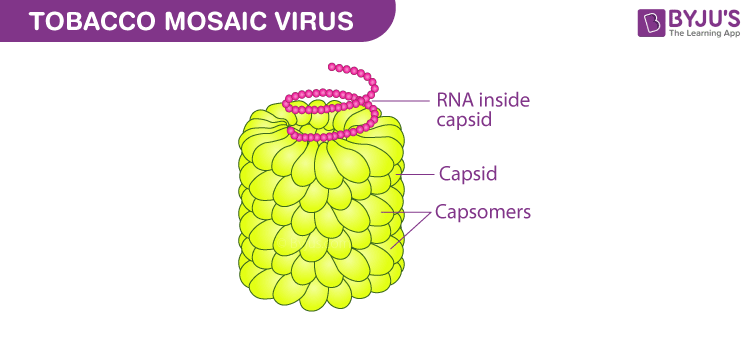Introduction
Tobacco mosaic virus (TMV) is a plant virus that belongs to the genus Tobamovirus. It is named so because it majorly infects tobacco plants, potatoes, tomatoes and other members of the Solanaceae family. The infection creates a mosaic like pattern, mottling and discoloration of the leaves. Let us look at the discovery, structure and lifecycle of the virus.
Discovery
Adolf Mayer, a German chemist first started studying the diseases in tobacco plants in 1879. By 1886 he was able to describe how leaf mottling disease was able to transfer from infected plants to healthy plants by rubbing infected plant juice over the healthy one, similar to bacterial infection.
Dmitri Ivanowsky, a Russian microbiologist, started investigating the tobacco mosaic disease between 1887 and 1890. He came to the conclusion that the causal organism could pass through the porcelain filter that was fine enough to hold the bacterial organisms and thus he believed that it was a non-bacterial infectious agency.
Later, Martinus Beijerinck replicated Ivanowsky’s work independently and showed that the causative agent was able to replicate and multiply in the tobacco plant host cell. Thus he coined the term ‘virus’ to show the non-bacterial nature of the tobacco mosaic disease.
Structure
- The tobacco mosaic virus (TMV) has a rod-like appearance that is 300 nm long with a diameter of 18 nm.
- It is covered by a protein shell called capsid that encloses the virus’s genetic material.
- The genetic material is a single-stranded RNA molecule.
- The capsid is made up of 2130 molecules of coat proteins that assemble in a rod-like helical structure possessing 16.3 proteins per helix turn.
- The RNA is found in a coiled manner inside the capsid coat and is made up of approximately 6395 nucleotides.
- It has structural chirality and inherent symmetry in the structure which gives the organism an easy way for chemical or genetic modifications.
Below is a simple and labelled diagram of TMV for your better understanding.

Life Cycle
The virus gets inside the plant host cells via vectors such as aphids, flies and other insects. After entering the host cell the virus starts to multiply and spreads to the nearby cells via plasmodesmata.
The virus can be transmitted to other healthy plants by coming in direct contact with the infected plants. For replication and multiplication inside the host cell, the viral particle releases its genomic material. The ssRNA then translates multiple mRNAs that can replicate the viral genome and the capsid proteins. All these proteins assemble to form a newly synthesised cell of tobacco mosaic virus that is ready to infect another cell.
Applications
Tobacco mosaic viruses are being widely used as viral vectors to deliver the gene of interest into plant cells and to produce plants with better quality and quantity. It also finds some use in biomaterial and nanotechnology devices.
Visit BYJU’S Biology for more information.
Also Read:
- A Detailed Overview of Virology
- What is the Difference between Virus and Bacteria?
- Solved Important MCQs on Virus and Their Characteristics
Frequently Asked Questions
Does Tobacco mosaic virus affect humans?
No, tobacco mosaic virus is a plant pathogen. It does not infect or replicate in humans or any other mammals.
Who isolated tobacco mosaic virus?
The credit of isolating TMV goes to Martinus Beijerinck.
Comments